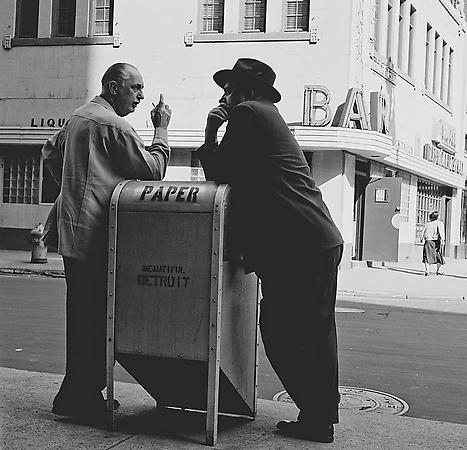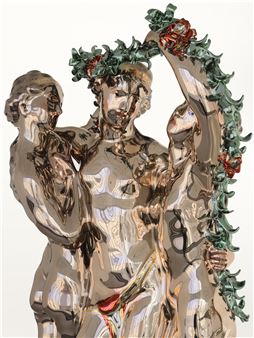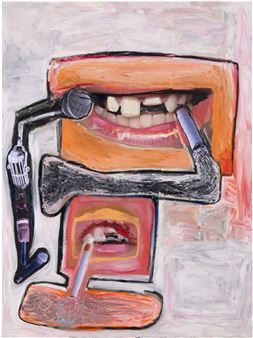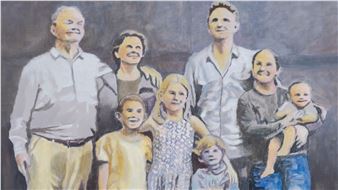Another Look at Detroit (Part I and II)
A joint project between Marianne Boesky Gallery and Marlborough Chelsea, Another Look at Detroit presents works and objects by over fifty artists, designers, and cultural contributors. The focus of this exhibition is the city of Detroit as a creative center, historically through to today. Spanning a period of 150 years, and taking place at both galleries’ Chelsea spaces, this exhibition is by no means a comprehensive survey. Rather, Another Look at Detroit intends to portray a vision as sprawling and complex as the biography of the city itself.
This is not an exhibition about geopolitics or macroeconomics or global finance. This is not an exhibition glorifying the misguided aesthetics of destruction porn. It is neither a feel-good exhibition trying to accentuate the positive, nor an attempt at organizing a proper historical overview of how a city was birthed and decayed.
This exhibition is a sprawling tone poem evoking the city where I was born and raised, a place I still feel deeply in my identity. A soliloquy by someone returning home, but not to the place they once knew.
Detroit was born in July 1701. In the 19th century, the city was the center of the nation’s carriage and wheel trade and stove industry. Henry Ford, a farmer, built his first automobile plant in Highland Park in 1899. General Motors was founded in 1908. A century later, on June 1, 2009, General Motors declared bankruptcy. This followed Chrysler, which had done so a month earlier. On July 18, 2013, Detroit filed for the largest municipal bankruptcy in the history of history.
Now, Detroit can no longer be ignored. Detroit has become epic, symbolic, historic - hip, even. Detroit is the birthplace of mass production, the automobile, the cement road, and credit on a mass scale. America’s way of life was built here. Now, it is the unemployment capital, where half the population does not work a consistent job. Detroit, which once led the nation in home ownership, is now a foreclosure capital. Once the nation’s richest large city, Detroit is now its poorest. Detroit, by some estimates, is 40% vacant.
Since its beginning, Detroit has been a place of perpetual flames, and not just the fires spewing forth from furnaces smelting iron transported directly to the River Rouge foundry, where it was poured into molds to make engine blocks. Three times the city has suffered race riots and three times the city has burned to the ground. The city’s flag acknowledges as much - Speramus Meliora; Resurget Cineribus - we hope for better things; it shall rise from the ashes.
People ask, “Where is the hope in Detroit?” This exhibition posits that some of that hope resides in Art. Not just Art itself, but those who create it, support it, critique it, curate it, exhibit it, and buy and sell it. There must be something that makes us want to continue. To believe in and support Art, in whatever manner our abilities allow, is to believe in that continuation.
We have believed in that kind of creativity. I know I still do. If I didn’t, why would I be bothering to curate such an exhibition? Certainly not to sit here and make a public announcement of the Apocalypse.
To share one’s critical feelings about the past, to try to describe and assess the present - all that implies a firm belief in a future.

Recommended for you
A joint project between Marianne Boesky Gallery and Marlborough Chelsea, Another Look at Detroit presents works and objects by over fifty artists, designers, and cultural contributors. The focus of this exhibition is the city of Detroit as a creative center, historically through to today. Spanning a period of 150 years, and taking place at both galleries’ Chelsea spaces, this exhibition is by no means a comprehensive survey. Rather, Another Look at Detroit intends to portray a vision as sprawling and complex as the biography of the city itself.
This is not an exhibition about geopolitics or macroeconomics or global finance. This is not an exhibition glorifying the misguided aesthetics of destruction porn. It is neither a feel-good exhibition trying to accentuate the positive, nor an attempt at organizing a proper historical overview of how a city was birthed and decayed.
This exhibition is a sprawling tone poem evoking the city where I was born and raised, a place I still feel deeply in my identity. A soliloquy by someone returning home, but not to the place they once knew.
Detroit was born in July 1701. In the 19th century, the city was the center of the nation’s carriage and wheel trade and stove industry. Henry Ford, a farmer, built his first automobile plant in Highland Park in 1899. General Motors was founded in 1908. A century later, on June 1, 2009, General Motors declared bankruptcy. This followed Chrysler, which had done so a month earlier. On July 18, 2013, Detroit filed for the largest municipal bankruptcy in the history of history.
Now, Detroit can no longer be ignored. Detroit has become epic, symbolic, historic - hip, even. Detroit is the birthplace of mass production, the automobile, the cement road, and credit on a mass scale. America’s way of life was built here. Now, it is the unemployment capital, where half the population does not work a consistent job. Detroit, which once led the nation in home ownership, is now a foreclosure capital. Once the nation’s richest large city, Detroit is now its poorest. Detroit, by some estimates, is 40% vacant.
Since its beginning, Detroit has been a place of perpetual flames, and not just the fires spewing forth from furnaces smelting iron transported directly to the River Rouge foundry, where it was poured into molds to make engine blocks. Three times the city has suffered race riots and three times the city has burned to the ground. The city’s flag acknowledges as much - Speramus Meliora; Resurget Cineribus - we hope for better things; it shall rise from the ashes.
People ask, “Where is the hope in Detroit?” This exhibition posits that some of that hope resides in Art. Not just Art itself, but those who create it, support it, critique it, curate it, exhibit it, and buy and sell it. There must be something that makes us want to continue. To believe in and support Art, in whatever manner our abilities allow, is to believe in that continuation.
We have believed in that kind of creativity. I know I still do. If I didn’t, why would I be bothering to curate such an exhibition? Certainly not to sit here and make a public announcement of the Apocalypse.
To share one’s critical feelings about the past, to try to describe and assess the present - all that implies a firm belief in a future.
Artists on show
- Allie McGhee
- Alvin Loving
- Ann Mikolowski
- Anna Sui
- Arnold Livshenko
- Arthur Nevill Kirk
- Bill Rauhauser
- Brenda Goodman
- Carl Milles
- Charles & Ray Eames
- Charles Eames
- Charles McGee
- Cyprien Gaillard
- Dana Schutz
- Destroy All Monsters
- Diego Rivera
- Eero Saarinen
- Eliel Saarinen
- Ellen Phelan
- Gari Melchers
- Gilda Snowden
- Gordon Newton
- Graem Whyte
- Harry Bertoia
- Hughie Lee-Smith
- James Chatelain
- James Lee Byars
- Jay Heikes
- Jim Shaw
- John Egner
- John Mix Stanley
- Julie Mehretu
- Kate Levant
- Keith Aoki
- Liz Cohen
- Loja Saarinen
- Marie T. Hermann
- Mary Ann Aitken
- Max Ortiz
- McArthur Binion
- Metroplex
- Michael & Katherine McCoy
- Michael E. Smith
- Michael Glancy
- Michael Luchs
- Michele Oka Doner
- Mike Kelley
- Mortimer L. Smith
- Morton Levin
- Nick Cave
- P. Scott Makela
- Percy Ives
- Pewabic Pottery
- Ray Eames
- Ray Johnson
- Richard Ritter
- Robert S. Duncanson
- Robert Sestok
- Scott Hocking
- Scott Reeder
- Shinola
- Tony Matelli
- Wallace MacMahon Mitchell
- William James Bennett
- Zoltan Sepeshy
Contact details


 ARTISTS
ARTISTS














